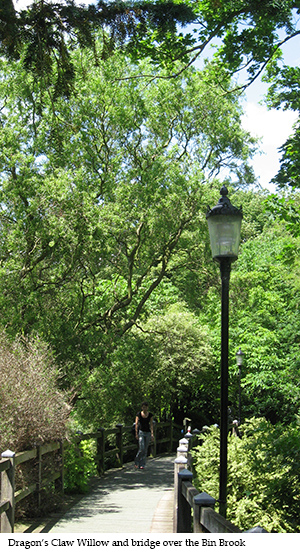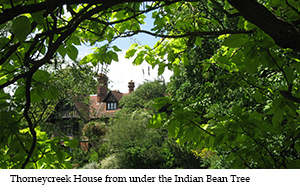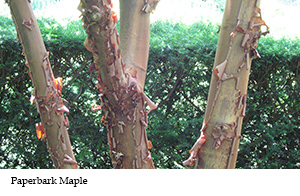Gardens
The Origin of Robinson College Gardens
A Guide to the Gardens with maps and species lists is available from the Porters' Lodge, price £5. Proceeds go to the National Garden Scheme charities. Opening times and the NGS scheme can be viewed by clicking on the tabs to the right.

Our College Gardens date back to late Victorian and Early Edwardian times and everyone is encouraged to enjoy this wonderful heritage together with the more recent landscaping and plantings. There are seats, benches and tables around for students to use and indeed the gardens are well used in the warm summer months for relaxation and study. This includes welcoming students to walk anywhere on the lawns. However, when the soil is wet in the winter we ask people to keep to the paths rather than taking short cuts and risk damaging the turf. Ball games are not allowed (there are sports fields nearby) but when the College is closed to the public in the Easter Term exam period, to help with relaxation students can play Frisbee and croquet. Outside the closed period the gardens are open under the National Garden Scheme (NGS) with entry via the Porters' Lodge where a Gardens Guide can be purchased in aid of the NGS charities such as Macmillan Cancer Support and Marie Curie. Further details on the NGS links highlighted in blue to the right.
Robinson College Gardens are a fusion of 10 pre-existing gardens which are subtly linked while still retaining their distinctive character. We now benefit from the plantings of the 1890's - early 1900's and from the focal water garden developed during the building of the College. Thus, magnificent mature trees and wilder areas are juxtaposed with more formal sections to make a diverse garden full of historical and horticultural interest which has become a haven for wildlife and a pleasure to the eye.
The plan chosen in 1974 for the building of the College was by Gillespie, Kidd and Coia, a firm of Glasgow architects. While other plans envisaged buildings throughout the site, theirs preserved much of the old gardens by building the new College around the sides of the site, with the gardens retained as a central feature. Thus the gardens you see today are actually a combination of no fewer than 10 original gardens. The largest is the central garden of Thorneycreek house, built in 1895. Four gardens of other houses now link into this on the Adams Road side, No 2 (built 1898), No. 4 (1908), No. 5 (1902) and No 6 (1890's) with one further garden at 1 Sylvester Road (1933). Additionally four houses were demolished in order to build the College - one in Adams Road and three in Herschel Road - and parts of their garden areas remain.

While the Gillespie plan originally favoured the idea of a natural garden with longer grassland, as was being promoted by the Dutch landscape gardeners at that time, the central area around the Bin Brook owes its character to the vision of the Landscape Architect, J.S. Bodfan Gruffydd. His 1979 plan sought to maintain diversity but to provide unity though linking the new College building to the Thorneycreek garden by means of an elevated walkway over the Bin Brook stream. He saw 'a wild woodland water garden'; focusing on the Bin Brook and a new small lake at the heart of the site, with a feeling of park and informal woodland, while at the same time keeping the sense of the more formal gardens beyond. Thus, the central area has a wide lawn running down to the pond, framed by many mature stately trees with much of the original planting intact, including a walnut tree planted in 1897 to commemorate Queen Victoria's Diamond Jubilee as well as the original plantings on Thorneycreek Terrace. There is an adjacent planting of yew hedges in a more formal arrangement, tempered with a weeping Wellingtonia, which reinforces the formal-informal juxtaposition. In 2014 a new terrace area, funded by generous donations, was created so that it overlooks the lake and people may now sit and enjoy the tranquil water scene.

The Adams Road Gardens have retained their original distinctive plantings while evolving through time. Each garden was developed by the original occupants, No. 2 by Lord and Lady Kaldor. Lord Kaldor was an economic advisor to successive Labour Governments and Lady Kaldor was a local Councillor. The garden still has their original herbaceous borders, espalier fruit trees and mulberry. The borders have been revitalised and an area has been planted with old varieties of fruit trees and wild flowers. The Maria Björnson Theatre is also in these gardens: constructed in 2004, this was funded by a Robinson Alumnus in memory of Maria Björnson who was a celebrated stage designer. Designing both sets and costumes, her work on Phantom of the Opera won her several awards worldwide. She also contributed to productions for the Royal National Theatre, The Royal Shakespeare Company, the Old Vic and productions for the Royal Opera House, English National Opera, Glyndebourne and La Scala. This outdoor theatre now sees student productions in term time and summer productions of Shakespeare. A new walnut tree was planted between the theatre and the lake in 2012 to mark the Diamond Jubilee of Queen Elizabeth II, thus complementing Queen Victoria's 1897 Diamond Jubilee walnut tree mentioned above. No 4 Adams Road was occupied by Dr Shillington-Scales who pioneered X-ray techniques in the garage. The garden retains his large lawn and was completely replanted during the construction of the Crausaz-Wordsworth building. No. 5 was occupied by a Mr P.A. Rottenberg who was a passionate collector of bulbs, many of which still remain, though his vegetable garden to the west of the present path has been re-planted with specimen trees. No. 6 was occupied by Lady Thomson, widow of Sir J. J. Thomson who was Master of Trinity College and discoverer of the electron. She sold her house to the College, stipulating that her Cyclamen hederifolium should not be lost - and it still flowers in the garden there to this day.
Apart from the main site, No. 3 Sylvester Road ('Sellenger') was occupied till 1970 by Lady Barlow, the last surviving grandchild of Charles Darwin and a cousin of the artist Gwen Raverat. Nora Barlow and her sister Ruth gave their childhood home ‘The Orchard’ and the Estate to New Hall in 1962 on which site the renamed Murray Edwards College now stands. She then moved to ‘Sellenger’ at 3 Sylvester Road, that house being incorporated into Robinson College on her death in 1989. Nora was a trained botanist and worked for the John Innes Institute from 1906, under William Bateson and studied plant genetics. She hybridised many plants including Aquilegia vulgaris var. stellata 'Nora Barlow', seeds of which she gave to nurseryman Alan Bloom. [Source: Cambridgeshire Gardens Trust newsletter 42, May 2017, p. 9]. Aquilegia ‘Nora Barlow’ is a double flower like a pom-pom, with pink petals and pale cream/lime green edging. This plant can still be found in Murray Edwards gardens and we have several flowering in the ‘Sellenger’ garden and also in No 2 Adams Road at Robinson. The Garden of Robinson Gardening Society is located at 'Sellenger'.
In the newer redeveloped areas around the main College building some of the original trees still stand with underplantings of spring bulbs next to the inner lawn. Other newer plantings comprise the Hall border, largely of Mediterranean shrubs, and commemorative trees, while outside the College the Grange Road silver birches and the Herschel Road plantings of shrubs now flourish with an extensive display of bulbs along the Grange Road frontage in the spring.
Dr. Christine Latham MRCVS,
Chair of the Gardens Committee
Acknowledgements:
The late Dr Stephen Trudgill - former Chair of the Gardens Committee, Mr Guy Fuller - Head Gardener, Dr Martin Brett, Mr Desmond O'Grady, Cdr. George Coupe and 'The Gardens of Cambridgeshire' by Cambridge Gardens Trust.